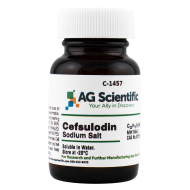1. Cefsulodin in the treatment of Pseudomonas meningitis Three patients with meningitis due to Pseudomonas aeruginosa (in one patient following a neurosurgical procedure and in two patients following severe head trauma with multiple skull bone fractures and liquorrhea) were treated with cefsulodin in combination with other antibiotics (aminoglycosides/acylureido penicillins). All of the patients were cured. Two patients received intraventricular administrations of aminoglycosides in addition to systemically applied antibiotics. After recurrence of pseudomonas meningitis in one patient in spite of the intraventricular application of an aminoglycoside, definite cure could only be obtained by additional intraventricular application of cefsulodin. The third patient was cured by systemic administration of cefsulodin and amikacin. The value of cefsulodin is discussed with reference to obtainable ventricular and lumbar CSF concentrations.
1. Cefsulodin in the treatment of Pseudomonas meningitis Three patients with meningitis due to Pseudomonas aeruginosa (in one patient following a neurosurgical procedure and in two patients following severe head trauma with multiple skull bone fractures and liquorrhea) were treated with cefsulodin in combination with other antibiotics (aminoglycosides/acylureido penicillins). All of the patients were cured. Two patients received intraventricular administrations of aminoglycosides in addition to systemically applied antibiotics. After recurrence of pseudomonas meningitis in one patient in spite of the intraventricular application of an aminoglycoside, definite cure could only be obtained by additional intraventricular application of cefsulodin. The third patient was cured by systemic administration of cefsulodin and amikacin. The value of cefsulodin is discussed with reference to obtainable ventricular and lumbar CSF concentrations. 2. Selective medium for Haemophilus influenza. Haemophilus influenzae is an important pathogen in patients with cystic fibrosis (CF), but may be difficult to detect in cultures of respiratory secretions because of overgrowth with Pseudomonas aeruginosa and Staphylococcus aureus. Cefsulodin is a semi-synthetic cephalosporin that has potent antibacterial (H.influenzae on a blood agar plate) activity against P. aeruginosa and some gram-positive bacteria including S.aureus but little effect against, H. influenzae and many other gram-negative rods. Thus the spectrum of antibacterial activity of cefsulodin is ideally suited for incorporation into selective media for the isolation of H. influenzae from the respiratory secretions of patients with CF. Other selective media for H. influenzae have used haemin and bacitracin, or N-acetyl-D-glucosamine as selective agents for haemophilus, but rely on anaerobic incubation to suppress the growth of P. aeruginosa The application of cefsulodin disks to the surface of culture plates has been used to create an antibiotic gradient to avoid the suppression of more sensitive strains of H. influenzae while inhibiting P. aeruginosa. The present study established the optimal concentration of cefsulodin for use in a selective medium for the isolation of H. influenzae from respiratory secretions of patients with CF. The effects of storage on stability of the medium were investigated and a trial of the new medium in comparison with non-selective chocolate blood agar and haemin-bacitracin blood agar in a dilution technique was undertaken. Cefsulodin provides the ideal spectrum of activity for this purpose and the results of the present study indicate that the incorporation of cefsulodin 8 mg/L into chocolate blood agar results in isolation rates at least as good as those obtained with haemin-bacitracin blood-based media, without the need for anaerobic incubation. 3. Selective medium for Yersinia enterocolitica Cefsulodin is used as a reagent in on CIN (Cefsulodin, Irgasan, and Novobiocin) agar (also called Yersinia Selective Agar) for the selective isolation of Yersinia enterocolitica. Y. enterocolitica has been well documented as a causative agent of gastrointestinal infections that invades the intestinal mucosa and lymph nodes. It is a major cause of enteric illness in the northern United States,Canada, and Europe. The properties of this medium are based on selective chemical agents, antibiotics, dyes, and the basal medium. It is highly selective against the growth of Escherichia coli, Klebsiella pneumoniae, Proteus mirabilis, Pseudomonas aeruginosa, Salmonella typhimurium, Shigella sonnei and Streptococcus faecalis. The characteristic deep red center with a transparent margin or bull's-eye appearance of Yersinia colonies is important for identification, and is due to the presence of mannitol. Y. enterocolitica ferments the mannitol in the medium, producing an acid pH which gives the colonies their red color and the bull's eye appearance. Studies have proved that CIN Agar is superior to SS (Salmonella-Shigella) Agar and MacConkey Agar in recovery rates of Y. enterocolitica from clinical specimens and food sources.|
CIN Agar Approximate Formula Per Liter Purified Water |
|
|
Pancreatic Digest of Gelatin |
10 g |
|
Peptic Digest of Animal Tissue |
5 g |
|
Beef Extract |
5 g |
|
Yeast Extract |
2 g |
|
Mannitol |
20 g |
|
Sodium pyruvate |
2 g |
|
Sodium chloride |
1 g |
|
Magnesium sulphate |
0.01 g |
|
Sodium desoxycholate |
0.5 g |
|
Neutral red |
0.03 g |
|
Crystal violet |
0.001 g |
|
Agar |
12.0 g |
|
Cefsulodin |
15 mg |
|
Irgasan |
4.0 mg |
|
Novobiocin |
2.5 mg |
